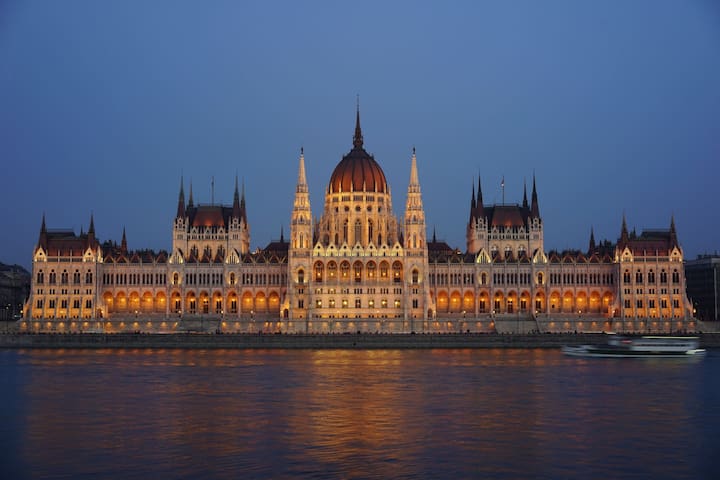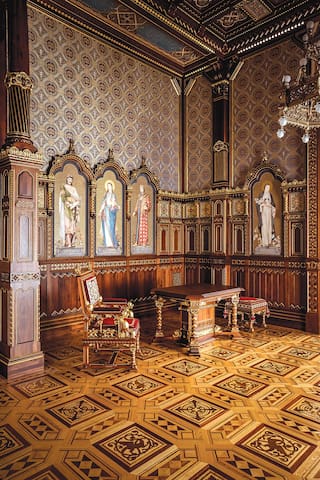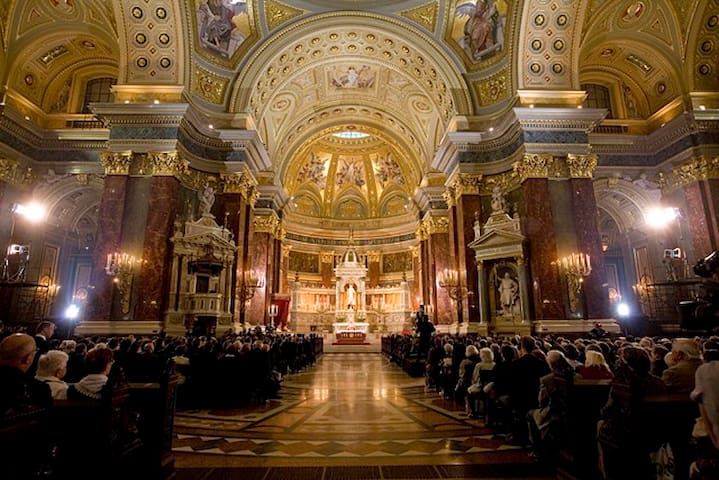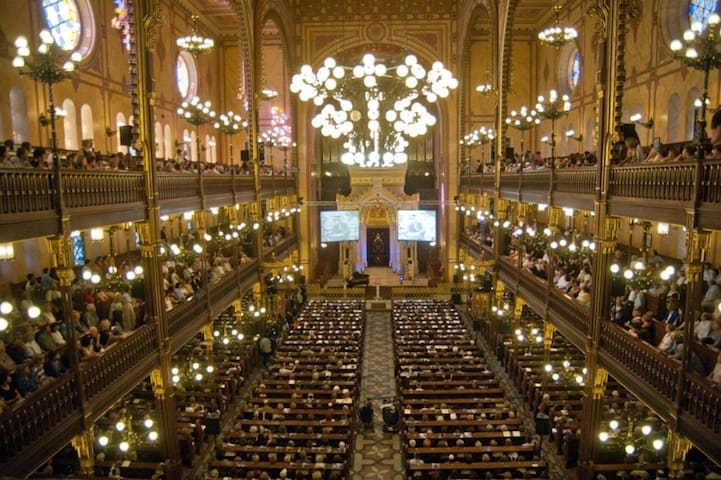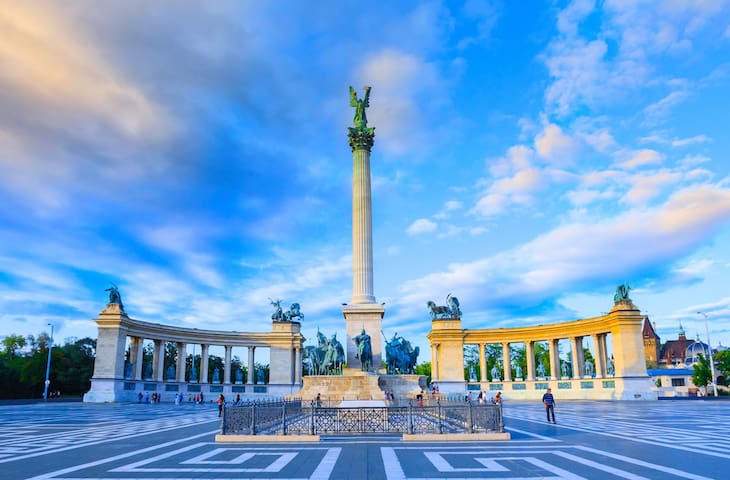Városnézés
The Hungarian Parliament Building (Hungarian: Országház, which translates to "House of the Country" or "House of the Nation"), also known as the Parliament of Budapest after its location, is the seat of the National Assembly of Hungary, a notable landmark of Hungary, and a popular tourist destination in Budapest. It is situated on Kossuth Square in the Pest side of the city, on the eastern bank of the Danube. It was designed by Hungarian architect Imre Steindl in neo-Gothic style and opened in 1902. It has been the largest building in Hungary since its completion.
1905 Recomendado por los habitantes de la zona
Edificio del Parlamento húngaro
1-3 Kossuth Lajos térThe Hungarian Parliament Building (Hungarian: Országház, which translates to "House of the Country" or "House of the Nation"), also known as the Parliament of Budapest after its location, is the seat of the National Assembly of Hungary, a notable landmark of Hungary, and a popular tourist destination in Budapest. It is situated on Kossuth Square in the Pest side of the city, on the eastern bank of the Danube. It was designed by Hungarian architect Imre Steindl in neo-Gothic style and opened in 1902. It has been the largest building in Hungary since its completion.
The Gellért Hill is the capital’s popular excursion place. The Citadel can also be found here.
The Hungarians call it a “mountain”, although at 235 metres, it is nowhere near the geographical definition of one. Nonetheless, with its steep craggy sides, trees changing colours with the seasons and architectural heritage, it forms an integral part of the Budapest landscape. On the Erzsébet bridge side and above the artificial waterfall stands the statue of its namesake Saint Gellért (Gerard). It was somewhere here that this monk, originally from Italy, died the death of a martyr in the 11th century. Saint Ivan’s cave is a famous legacy of the hill, which, after its expansion, now serves as the site for the Cave Church, a chapel of the Paulite monastic order. The Philosophers’ Garden is situated on the side of the hill nearest Castle Hill - a unique group of statues which commemorates the religions of the world. A richly diverse arboretum can be found there as well, a little farther from the Danube. The fortress located on the top of the hill was erected by the Habsburg rulers after the 1848-1849 revolution and war for independence was crushed. The Liberty Statue which stands in front of the fortress is of a female figure holding up a palm leaf. This is perhaps the most popular spot from which to view the city, as thousands of tourists stream by every day. However, many locals also stroll up the hill for a bit of fresh air and quiet, or to rest on the lawns.
430 Recomendado por los habitantes de la zona
Colina Gellért
The Gellért Hill is the capital’s popular excursion place. The Citadel can also be found here.
The Hungarians call it a “mountain”, although at 235 metres, it is nowhere near the geographical definition of one. Nonetheless, with its steep craggy sides, trees changing colours with the seasons and architectural heritage, it forms an integral part of the Budapest landscape. On the Erzsébet bridge side and above the artificial waterfall stands the statue of its namesake Saint Gellért (Gerard). It was somewhere here that this monk, originally from Italy, died the death of a martyr in the 11th century. Saint Ivan’s cave is a famous legacy of the hill, which, after its expansion, now serves as the site for the Cave Church, a chapel of the Paulite monastic order. The Philosophers’ Garden is situated on the side of the hill nearest Castle Hill - a unique group of statues which commemorates the religions of the world. A richly diverse arboretum can be found there as well, a little farther from the Danube. The fortress located on the top of the hill was erected by the Habsburg rulers after the 1848-1849 revolution and war for independence was crushed. The Liberty Statue which stands in front of the fortress is of a female figure holding up a palm leaf. This is perhaps the most popular spot from which to view the city, as thousands of tourists stream by every day. However, many locals also stroll up the hill for a bit of fresh air and quiet, or to rest on the lawns.
The Várkert Bazár is Budapest's unique jewelery box where art and nature complement each other. It is a distinctive work of architecture capable of offering an experience of history, culture and nature all at the same time, which makes it the perfect venue for entertainment, leisure and cultural events.
128 Recomendado por los habitantes de la zona
Jardín del Castillo Bazaar
2-6 Ybl Miklós térThe Várkert Bazár is Budapest's unique jewelery box where art and nature complement each other. It is a distinctive work of architecture capable of offering an experience of history, culture and nature all at the same time, which makes it the perfect venue for entertainment, leisure and cultural events.
The coronation of Franz Joseph as King of Hungary in 1867 reinforced the need for expansion and improvement to make the Royal Palace on Castle Hill into a true royal residence. Leadership of this project was assigned, after the death of Miklós Ybl, to another renowned architect of the day, Alajos Hauszmann. His work resulted in a palace complex that ranked among the most distinguished royal buildings of Europe in the early 20th century. In addition to completely renewing the exterior architecture, Hauszmann designed interiors that befitted a royal residence.
Szent István-terem
2 Szent György térThe coronation of Franz Joseph as King of Hungary in 1867 reinforced the need for expansion and improvement to make the Royal Palace on Castle Hill into a true royal residence. Leadership of this project was assigned, after the death of Miklós Ybl, to another renowned architect of the day, Alajos Hauszmann. His work resulted in a palace complex that ranked among the most distinguished royal buildings of Europe in the early 20th century. In addition to completely renewing the exterior architecture, Hauszmann designed interiors that befitted a royal residence.
The Halászbástya or Fisherman's Bastion is one of the best known monuments in Budapest, located near the Buda Castle, in the 1st district of Budapest. It is one of the most important tourist attractions due to the unique panorama of Budapest from the Neo-Romanesque lookout terraces. The Fishermen's Bastion's main façade, parallel to the Danube, is approximately 140 meters long, of which the southern aisle is about 40 meters long, the north is 65 meters long, and the ornate central parapet is 35 meters long. Its seven high-pitched stone towers symbolize the seven chieftains of the Hungarians who founded Hungary in 895.
666 Recomendado por los habitantes de la zona
Fishermen's Bastion
Szentháromság térThe Halászbástya or Fisherman's Bastion is one of the best known monuments in Budapest, located near the Buda Castle, in the 1st district of Budapest. It is one of the most important tourist attractions due to the unique panorama of Budapest from the Neo-Romanesque lookout terraces. The Fishermen's Bastion's main façade, parallel to the Danube, is approximately 140 meters long, of which the southern aisle is about 40 meters long, the north is 65 meters long, and the ornate central parapet is 35 meters long. Its seven high-pitched stone towers symbolize the seven chieftains of the Hungarians who founded Hungary in 895.
The House of Hungarian Music is a tree of life in the heart of the City Park, with a trunk, and a crown of golden leaves on slender branches. We are standing here by its roots, which provide the institution with its spiritual sustenance. The roots are entwined, like a labyrinth, and we walk among them. Our journey begins far back in time and space, back at the birth of music itself where we can grasp the roots of Hungarian folk music and European music. Progressing through the centuries, we will follow the development of music, discovering what a series of organised tones has meant to mankind, with the emphasis on Hungarians in the light—or sometimes the shadow—of Europe. Through the language of music, the exhibition speaks for itself: Everywhere we go, we hear music playing; the subject of the exhibition is music itself. Quoting Shakespeare, we might say, “Mark the music!” Mark not only the music coming from the headphones, but also the music around and within you. When you reach the end of the path, the modern day, many sounds will have been etched into your heart and mind: music to take home with you, the music of ancient times.
23 Recomendado por los habitantes de la zona
Magyar Zene Háza
3 Olof Palme sétányThe House of Hungarian Music is a tree of life in the heart of the City Park, with a trunk, and a crown of golden leaves on slender branches. We are standing here by its roots, which provide the institution with its spiritual sustenance. The roots are entwined, like a labyrinth, and we walk among them. Our journey begins far back in time and space, back at the birth of music itself where we can grasp the roots of Hungarian folk music and European music. Progressing through the centuries, we will follow the development of music, discovering what a series of organised tones has meant to mankind, with the emphasis on Hungarians in the light—or sometimes the shadow—of Europe. Through the language of music, the exhibition speaks for itself: Everywhere we go, we hear music playing; the subject of the exhibition is music itself. Quoting Shakespeare, we might say, “Mark the music!” Mark not only the music coming from the headphones, but also the music around and within you. When you reach the end of the path, the modern day, many sounds will have been etched into your heart and mind: music to take home with you, the music of ancient times.
St Stephen’s Basilica of Budapest is one of the most beautiful and significant churches and touristic attractions of the country. This is partly due to its historical heritage, of being dedicated to the holy king St Stephen who was also the founder of the Hungarian state, and partly to the architectural and artistic value of the building itself.
1262 Recomendado por los habitantes de la zona
Basílica de San Esteban (Szent Istvan Bazilika)
1 Szent István térSt Stephen’s Basilica of Budapest is one of the most beautiful and significant churches and touristic attractions of the country. This is partly due to its historical heritage, of being dedicated to the holy king St Stephen who was also the founder of the Hungarian state, and partly to the architectural and artistic value of the building itself.
The Széchenyi Medicinal Bath in Budapest, (Hungarian: Széchenyi gyógyfürdő) is the largest medicinal bath in Europe.
1248 Recomendado por los habitantes de la zona
Széchenyi Thermal Bath
9-11 Állatkerti krt.The Széchenyi Medicinal Bath in Budapest, (Hungarian: Széchenyi gyógyfürdő) is the largest medicinal bath in Europe.
The Dohány Street Synagogue, also known as the Great Synagogue or Tabakgasse Synagogue, is a historical building in Erzsébetváros, the 7th district of Budapest, Hungary. It is the largest synagogue in Europe, seating 3,000 people and is a centre of Neolog Judaism.
1302 Recomendado por los habitantes de la zona
Dohány Street Synagogue
2 Dohány u.The Dohány Street Synagogue, also known as the Great Synagogue or Tabakgasse Synagogue, is a historical building in Erzsébetváros, the 7th district of Budapest, Hungary. It is the largest synagogue in Europe, seating 3,000 people and is a centre of Neolog Judaism.
Gül Baba's tomb (türbe) in Budapest, Hungary, is the northernmost Islamic pilgrimage site in the world. The mausoleum is located in the district of Rózsadomb on Mecset (mosque) Street, a short but steep walk from Margaret Bridge.
Gül Baba was a member of the Bektás Dervish Order, who died in Ottoman Buda in 1541.
91 Recomendado por los habitantes de la zona
Gül Baba y el Jardín de Rosas
14 Mecset u.Gül Baba's tomb (türbe) in Budapest, Hungary, is the northernmost Islamic pilgrimage site in the world. The mausoleum is located in the district of Rózsadomb on Mecset (mosque) Street, a short but steep walk from Margaret Bridge.
Gül Baba was a member of the Bektás Dervish Order, who died in Ottoman Buda in 1541.
Hősök tere, lit. Heroes' Square, is one of the major squares in Budapest, Hungary, noted for its iconic Millennium Monument with statues featuring the Seven chieftains of the Magyars and other important Hungarian national leaders, as well as the Memorial Stone of Heroes, often erroneously referred as the Tomb of the Unknown Soldier. The square lies at the outbound end of Andrássy Avenue next to City Park (Városliget). It hosts the Museum of Fine Arts and the Palace of Art (Műcsarnok). The square has played an important part in contemporary Hungarian history and has been a host to many political events, such as the reburial of Imre Nagy in 1989. Most sculptures were made by sculptor György Zala from Lendava, with one made by György Vastagh.
942 Recomendado por los habitantes de la zona
Plaza de los Héroes
Hősök tereHősök tere, lit. Heroes' Square, is one of the major squares in Budapest, Hungary, noted for its iconic Millennium Monument with statues featuring the Seven chieftains of the Magyars and other important Hungarian national leaders, as well as the Memorial Stone of Heroes, often erroneously referred as the Tomb of the Unknown Soldier. The square lies at the outbound end of Andrássy Avenue next to City Park (Városliget). It hosts the Museum of Fine Arts and the Palace of Art (Műcsarnok). The square has played an important part in contemporary Hungarian history and has been a host to many political events, such as the reburial of Imre Nagy in 1989. Most sculptures were made by sculptor György Zala from Lendava, with one made by György Vastagh.
Gasztronómia
If you love fresh goods, people watching, shopping, photo opportunities, guided tours with tastings, or just sightseeing in amazing places, we trust you will enjoy visiting our beloved Great Market Hall. No matter if it rains or shines, the Great Market Hall is a great option, and definitely one of the top Budapest attractions according to many Budapest guides.
1242 Recomendado por los habitantes de la zona
Mercado Central de Budapest
1-3 Vámház krt.If you love fresh goods, people watching, shopping, photo opportunities, guided tours with tastings, or just sightseeing in amazing places, we trust you will enjoy visiting our beloved Great Market Hall. No matter if it rains or shines, the Great Market Hall is a great option, and definitely one of the top Budapest attractions according to many Budapest guides.
Chocolate Rózsavölgyi
2-4 Királyi Pál u.
